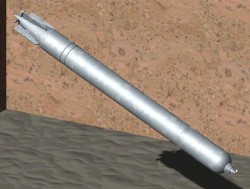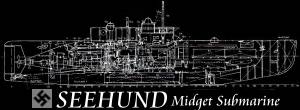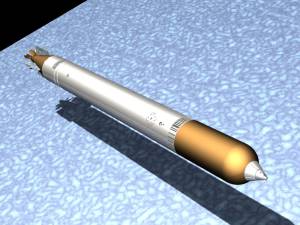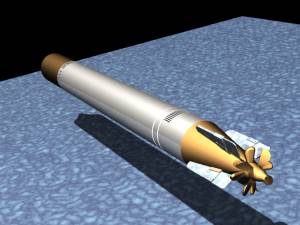The various types of the
German torpedoes  |
T1
- (G7a) |
Diameter
: |
53.34
cm |
| Length
: |
7.163m |
| Weight
: |
1538
kg |
| Propulsion
: |
Thermic
energy |
| Power
: |
350
hp |
|
Range & Speed : |
44
knots to 5,000m / 40 knots to 7,500m / 30 knots to 12,500m |
Warhead
: |
280 kg |
| Guidance
system : |
Direct
firing Fat or LUT |
| Description
: |
The prewar issue torpedo T I was propelled by a steam engine (Compressed air). It was
quite reliable and could make up to 12.5 kilometers. Anyway this torpedo type left a
stream of bubbles after it, because of its propulsion, giving the targeted ship a chance
of seeing it coming. Therefore the T I was to be used at night. |
T1
- (G7ut K. But Type) |
Diameter
: |
53.34
cm |
| Length
: |
7.163m |
| Weight
: |
1309
kg |
| Propulsion
: |
Walteer
Turbine |
| Power
: |
425
hp |
|
Range & Speed : |
45
knots to 2,800m |
Warhead
: |
280 kg |
| Guidance
system : |
Direct
firing |
| Description
: |
|
T1
- (G7a Type) |
Diameter
: |
53.34
cm |
| Length
: |
7.163m |
| Weight
: |
1352
kg |
| Propulsion
: |
Thermic
energy |
| Power
: |
280
hp |
|
Range & Speed : |
34
knots to 2,500m |
Warhead
: |
280 kg |
| Guidance
system : |
Direct
firing |
| Description
: |
|
T2
- (G7e)
 |
Diameter : |
53.34
cm |
| Length: |
7.163 m |
|
Weight: |
1608
kg |
|
Propulsion: |
Electric motor |
| Power
: |
100
hp |
|
Range & Speed: |
30
knots at 5,000m |
Warhead
: |
280 kg |
| Guidance
system : |
Direct
firing |
|
Description
:
|
The standard issue German torpedo of W.W.II. This all battery powered torpedo type left no
trails on the surface and was suitable for attacks in daylight. A great improvement!
However the electric torpedo could not make as good range as the steam powered ones and it
had to be looked after, getting serviced, every three or four days. Before the Norwegian
campaign the T II had problems with its depth keeping equipment as well as with its firing
pistol. |
T3
- (G7e) |
Diameter
: |
53.34
cm |
Length
: |
7.163
m |
| Weight
: |
1608
kg |
| Propulsion
: |
All
electric propulsion system |
| Power
: |
100
hp |
|
Range & Speed : |
30
knots at 5,000m |
| Warhead
: |
280 kg
(TNT - Trinitrotoluene)
(HND - hexanitrophenylamine) |
| Guidance
system : |
Direct
firing or Fat |
| Description
: |
T III was "the same" as the T II though it was fitted with an influence fuse! |
T3a
- FAT (G7e) |
Length:
Weight:
Propulsion:
Range & Speed:
Warhead: |
7.163
m
?
Electric motor
7.5 km at 30 kts
274 kg (280 kg ?)
The FAT (Flachenabsuchender torped = area searching torpedo) was a pattern running torpedo
made especially for convoy attacks. The torpedo was pre set to run in a zig zag pattern!
First it went straight, turned over to left or right and proceeded for 800 or 1600 meters
making the next turn opposite.
A lethal weapon getting inside a convoy. |
T3b
- (G7a) |
Length:
Weight:
Propulsion:
Range & Speed:
Warhead: |
7.163
m
1352 kg
Electric motor
? km at 18.5 kts
280 kg
Made for the midget sub "Marder". |
T3c
- (G7a) |
Length:
Weight:
Propulsion:
Range & Speed:
Warhead: |
7.163
m
1352 kg
Electric motor
? km at 18.5 kts
280 kg
Made for the midget sub "Seehund". |
T3d
- (G7e) |
Length:
Weight:
Propulsion:
Range & Speed:
Warhead: |
11.0
m
2200 kg
Electric motor
? km at 9 kts
280 kg
This torpedo was also named "Dackel".
Made for special operations. |
T4
- (G7es)
Falke |
Diameter : |
53.34
cm |
|
Length: |
7.163
m |
|
Weight: |
1400 kg (approx.) |
|
Propulsion: |
Electric motor |
|
Power : |
32
hp |
|
Range & Speed: |
7.5 km at 20 kts |
Warhead: |
274 kg (280 kg ?) |
|
Guidance system : |
Acoustical
self-guidance |
|
Description
:
|
Also known as the "Falke" this type was the first homing torpedo as It was
fitted with a passive acoustic homing device and made to be launched against escort
vessels. Its slow speed and the fact that it had no magnetic detonator made it to be a
small help in the warfare.A very small number of the T IV were used, when
the next generation of this type was at hand. |
T5
- (G7es)
Zaunkönig type |
Diameter : |
53.34
cm |
|
Length: |
7.163
m |
|
Weight: |
1495 kg (approx.) |
|
Propulsion: |
Electric motor |
|
Power : |
55
hp |
|
Range & Speed: |
5.7 km at 24 kts |
Warhead: |
274 kg |
|
Guidance system : |
Acoustical
self-guidance |
|
Description
:
|
Also known as "Zaunkönig 1" This torpedo type was (as the "Falke") an
acoustic homing torpedo to be searching for the propeller noise of the target (actually
searching for the
largest noise in the area). The development for creating accurate homing torpedoes had
started as early as in the mid 30s but made slow progress. The T V was an improved version
of the acoustic
torpedo. It was faster and had both a magnetic and a contact detonator. The Zaunkonig had
even better detection equipment with better sensitivity locating the propeller sounds. But
this torpedo also had its weak points. In hard weather conditions it was detonating to
early as well as it could detonate far behind or beyond a ship. The allied forces soon
found out that the active range of its detection gear was only sensitive to ships sailing
at about 15 knots! Skippers got to know that if they either lowered the speed or went
faster than 14-16 knots the torpedo would get serious problems spotting them. They also
developed anti "GNAT" (as the allies called the torpedo) devices dragged after
an escort vessel making a loud noise to attract possible homing torpedoes in the area. |
T8
- G7ut
Steinbutt Type |
Diameter : |
53.34
cm |
| Length: |
7.163
m |
|
Weight: |
1730
kg |
|
Propulsion: |
Walteer
turbine |
|
Power : |
430
hp |
|
Range & Speed: |
8
km at 45 kts |
Warhead: |
280 kg |
|
Description
:
|
Improved version of the T V as an answer to the allied anti homing devices. Although never
used in combat. |
|
Notes :
Fat : Flähchen Absuchender Torpedo ( Circular search torpedo )
LUT : Lageunabhängiger Torpedo : torpille à évolution en zig-zag
Falke : falcon |

 German torpedo
nomenclature can be extremely confusing. There were, however, only two
principal types of torpedo used on U-boats, but with several variants in
detonating devices (the pistol) and in directional control. These two
principal types were in fact developments of torpedoes used in World War
I, the G7a and the G7e. By World War II, torpedo sizes had been
standardized at 54cm (21 in) so that all torpedoes, whether launched from
surface ships or U-boats, were of the same diameter. The standard length
was 7.16m and some 280 kg of explosive was contained in the warhead.
German torpedo
nomenclature can be extremely confusing. There were, however, only two
principal types of torpedo used on U-boats, but with several variants in
detonating devices (the pistol) and in directional control. These two
principal types were in fact developments of torpedoes used in World War
I, the G7a and the G7e. By World War II, torpedo sizes had been
standardized at 54cm (21 in) so that all torpedoes, whether launched from
surface ships or U-boats, were of the same diameter. The standard length
was 7.16m and some 280 kg of explosive was contained in the warhead.
